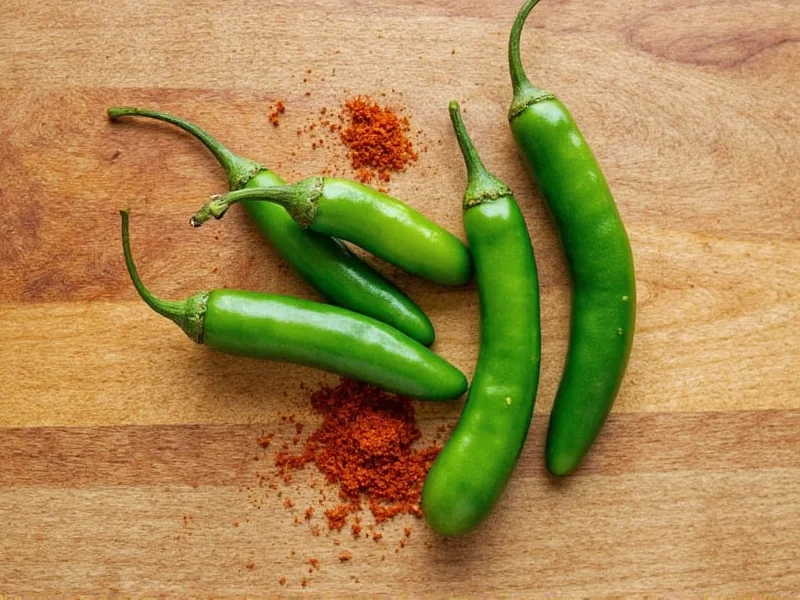Understanding jalapeño spice level helps home cooks and food enthusiasts make informed decisions in the kitchen. These popular peppers serve as the gateway chili for many people exploring spicy foods, but their heat can surprise the unprepared. The Scoville scale, developed by pharmacist Wilbur Scoville in 1912, remains the standard measurement for chili pepper heat intensity.
Where Jalapeños Fall on the Scoville Scale
Jalapeños occupy a middle ground in the world of chili peppers. While significantly milder than habaneros or ghost peppers, they pack more heat than bell peppers or poblanos. The Scoville scale measures capsaicin concentration—the compound responsible for a pepper's burn—in Scoville Heat Units (SHU).
| Pepper Variety | Scoville Heat Units (SHU) | Heat Level |
|---|---|---|
| Jalapeño | 2,500–8,000 | Mild to Medium |
| Serrano | 10,000–23,000 | Medium to Hot |
| Habanero | 100,000–350,000 | Very Hot |
| Bell Pepper | 0 | None |
| Thai Bird's Eye | 50,000–100,000 | Hot |
Factors That Influence Jalapeño Heat Level
Several variables affect the actual spiciness of jalapeños you encounter:
Ripeness and Color
Green jalapeños (unripe) generally deliver milder heat than their red counterparts (fully ripe). As jalapeños mature and change color from green to red, their capsaicin concentration increases, resulting in more intense heat. Red jalapeños also develop sweeter, fruitier notes alongside the increased spiciness.
Growing Conditions
Environmental stress significantly impacts jalapeño heat. Peppers grown in hotter, drier conditions with less water typically produce more capsaicin as a defense mechanism. Soil quality, sunlight exposure, and temperature fluctuations all contribute to the final heat level. Commercial growers sometimes manipulate these conditions to produce consistently mild jalapeños for mass markets.
Individual Variation
Even within the same plant, jalapeños show considerable variation in heat. The white pithy ribs inside the pepper contain the highest concentration of capsaicin, so seeds and membranes contribute significantly to the overall heat experience. Two jalapeños from the same batch can differ noticeably in spiciness due to natural biological variation.
Practical Implications for Cooking
Knowing jalapeño spice level helps you control heat in recipes. For milder results, remove all seeds and white membranes before chopping. Wear gloves when handling hot peppers to prevent capsaicin transfer to sensitive areas. Remember that cooking doesn't eliminate capsaicin—it distributes the heat throughout your dish.
When substituting jalapeños in recipes, consider these jalapeño heat level comparisons: one jalapeño typically equals 1/4 to 1/2 teaspoon of cayenne pepper, depending on the jalapeño's actual heat. For those sensitive to spice, start with half a jalapeño and adjust to taste.
Safety Tips for Handling Hot Peppers
Always wash hands thoroughly after handling jalapeños, especially before touching your face. Avoid using latex gloves as capsaicin can penetrate them. If you experience burning sensations, dairy products like milk or yogurt provide relief better than water, which spreads the oil. Never rub your eyes after handling hot peppers—a painful lesson many cooks learn the hard way.
Understanding Jalapeño Heat Variability
The jalapeño spice level range (2,500–8,000 SHU) represents significant variability. This broad spectrum explains why some jalapeños taste barely spicy while others deliver a noticeable kick. Modern agricultural practices have developed specific jalapeño cultivars with more consistent heat levels, but natural variation remains inherent to the plant.
When shopping for jalapeños, look for smooth, firm skin without wrinkles, which indicates freshness. Some grocery stores now label jalapeños as "mild" or "hot" based on their testing. Farmers' market jalapeños often show more heat variation than supermarket varieties due to less standardized growing conditions.
Common Questions About Jalapeño Heat
How does jalapeño heat compare to other common peppers?
Jalapeños (2,500–8,000 SHU) are hotter than poblanos (1,000–2,000 SHU) but milder than serranos (10,000–23,000 SHU). They're significantly less spicy than habaneros (100,000–350,000 SHU) but pack more heat than bell peppers (0 SHU). One jalapeño roughly equals 1/4 to 1/2 teaspoon of cayenne pepper in heat intensity.
Why do some jalapeños taste hotter than others?
Jalapeño heat varies due to growing conditions, ripeness, and individual plant genetics. Stress factors like drought or extreme heat increase capsaicin production. Red jalapeños (fully ripe) typically run hotter than green ones. Even within the same pepper, the seeds and white ribs contain more capsaicin than the flesh.
How can I reduce the heat of jalapeños in cooking?
To reduce jalapeño spice level, remove all seeds and white membranes—the hottest parts. Soaking chopped jalapeños in salt water or milk for 15-30 minutes can extract some capsaicin. Cooking with dairy ingredients like cheese or sour cream helps balance the heat. Start with less pepper and add more gradually to achieve your preferred spice level.
Are red jalapeños hotter than green jalapeños?
Yes, red jalapeños are typically hotter than green ones. As jalapeños ripen and turn from green to red, their capsaicin concentration increases. Red jalapeños also develop sweeter, fruitier flavors alongside the increased heat. The color change indicates full maturity, which correlates with higher heat levels in most cases.
What's the best way to handle very hot jalapeños safely?
When handling particularly hot jalapeños, wear nitrile gloves (not latex) to prevent capsaicin transfer. Work in a well-ventilated area as cutting releases capsaicin vapors. Avoid touching your face, especially eyes. After handling, wash hands thoroughly with soap and water, then use a dairy-based product like milk to neutralize any remaining oils. Never rub your eyes after handling hot peppers.











 浙公网安备
33010002000092号
浙公网安备
33010002000092号 浙B2-20120091-4
浙B2-20120091-4